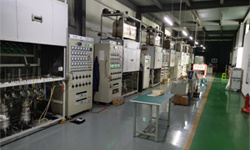
Blog
Discussion on Classification of Industrial CT Ray Tube
2021-11-12
Industrial CT (Computed Tomography) is an important non-destructive inspection and three-dimensional imaging technology, widely used in manufacturing, materials science and other fields. In the industrial CT system, the ray tube is one of the key components, which produces the beam used for imaging. In different application scenarios, industrial CT ray tubes are classified according to their characteristics and uses. This article will introduce four main categories of industrial CT tubes: micro-focus tubes, nano-focus tubes, small-focus tubes, and high-speed tubes.
Micro Focus Ray Tube and Nano Focus Ray Tube
A microfocus tube, which produces a beam with a very small focal spot size, usually on the micrometer scale. This tube is specially used for applications that require high-resolution imaging. It is suitable for the inspection of tiny parts, fine structures and thin sheet materials, and can show smaller-sized details inside objects.
Nano-focus ray tubes are further developed on the basis of micro-focus ray tubes, which produce smaller beam focus sizes, usually at the nanometer level. Such tubes are suitable for high-resolution imaging of tiny samples or nano-scale structures, and have important applications in nanotechnology and materials science research, capable of revealing finer structures and features.
small focus ray tube
Small focus ray tube is another important classification, although its focus size accuracy is not as accurate as micro focus and nano focus ray tube, but it still plays an important role in practical applications. The focus size of the beam it produces is between the microfocus and the general focus. This design goal balances the resolution and imaging speed to a certain extent. The small focus tube is suitable for imaging medium-sized samples, can obtain relatively high resolution, and can also cope with some relatively large samples.
Although the resolution of the small focus ray tube is relatively low, its imaging effect is still very valuable in practical engineering and scientific fields. It can obtain imaging results in a short time, is suitable for the detection and analysis of medium-sized samples, and is suitable for a wider range of application requirements.
High Speed Ray Tube and General Ray Tube
High-speed tubes are another important type of industrial CT tube. It produces a beam capable of rapid pulses and is suitable for applications requiring real-time imaging of dynamic processes. If you need to capture changes in materials during loading or deformation, or if you want to observe transient processes such as fluid flow, high-speed tubes can provide high-frequency imaging with high temporal resolution.
In contrast, the general tube is usually referred to as a traditional tube, which produces a continuous beam of rays and is suitable for static imaging. Such a tube can be used in the field of static imaging, such as industrial CT scanning, medical X-ray imaging, etc., where the object being imaged does not need to change rapidly during the imaging process.
In industrial CT applications, it is crucial to select the type of tube suitable for a particular task. Micro-focus (or nano-focus), small focus and high-speed ray tube are used for high-resolution imaging and real-time monitoring of dynamic processes, while general ray tubes are widely used in the field of static imaging.
Previous Page
[Related professional knowledge] X-ray tube
2024/08/02
Introduction of X-ray tube related terms
2023/11/01





